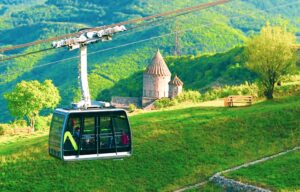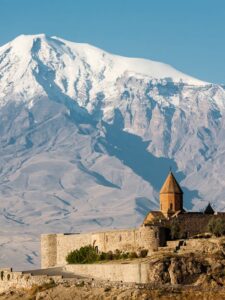Top-10 to Do
Top 10 Things to Do in Armenia

To have a cup of Armenian coffee
Drinking coffee in Armenia, like in the whole world, is associated with a pleasant rest or a break during the day. In Armenia, the so-called black coffee is mostly of high demand and popular. Although coffee does not grow in Armenia, it is difficult to find a more "Armenian" drink than coffee. Here, it is impossible to pay a visit to an Armenian's house and not to be offered to take a cup of coffee. In general, the Armenian abundant hospitality, regardless of the event format and the variety of dishes being previously prepared for the event, begins and ends with coffee.
Drinking coffee in Armenia, like in the whole world, is associated with a pleasant rest or a break during the day. In Armenia, the so-called black coffee is mostly of high demand and popular. Although coffee does not grow in Armenia, it is difficult to find a more "Armenian" drink than coffee. Here, it is impossible to pay a visit to an Armenian's house and not to be offered to take a cup of coffee. In general, the Armenian abundant hospitality, regardless of the event format and the variety of dishes being previously prepared for the event, begins and ends with coffee. The use of coffee has almost become a ritual. Employees of the same office, musicians of the same orchestra, programmers discussing deadlines, on-duty doctors already have well-set up coffee hours and favorite places that turn coffee drinking into a traditional daily activity.
When the muse does not appear for a long time, people of art often turn to their "old and good friends". "Coffee is the companion with which the writer's work ceases to be torturous," said Balzac, a great coffee lover. By the way, it is noteworthy that Armenians call the foam that forms on the surface of coffee shortly before boiling "love". According to statistics, the average person who drinks coffee in Armenia consumes 3.5-4 kg of coffee a year, which is about 67 liters.
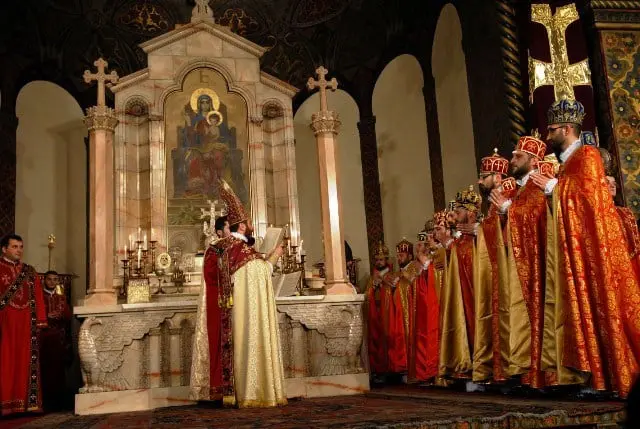
Attend a Sunday service
Christianity was first introduced in Armenia by the apostles Bartholomew and Thaddeus in the first century AD. Armenia was the first nation to adopt Christianity as a state religion – in 301 AD. Armenian state and Armenian people has always been dedicated to their church since the date of its foundation, and Armenian Apostolic Church has always been an independent church with its own doctrine and Patriarch (Catholicos) throughout its` long history. The liturgy is the main Christian theological service.
Christianity was first introduced in Armenia by the apostles Bartholomew and Thaddeus in the first century AD. Armenia was the first nation to adopt Christianity as a state religion – in 301 AD. Armenian state and Armenian people has always been dedicated to their church since the date of its foundation, and Armenian Apostolic Church has always been an independent church with its own doctrine and Patriarch (Catholicos) throughout its` long history. The liturgy is the main Christian theological service. It symbolizes the sacrifice of Jesus Christ. By attending the Liturgy of the Armenian Apostolic Church the person not only takes part in an important spiritual event, but also penetrates the deepest cultural and spiritual layers of country. Attending the Sunday liturgy in Armenian Church is an interesting and unique experience, since it is very different both from Catholic and Orthodox service. Over the centuries, the liturgy has undergone very few ritual changes. Armenian Apostolic Church stays very close the oldest genuine church phenomenon, since it has changed very few things all the way back from 5 th century. If you are lucky enough to attend a Sunday service in Echmiadzin Mother Cathedral, you are going to witness a very beautiful ceremony of accompanying Catholicos to the service, which happens almost every Sunday.
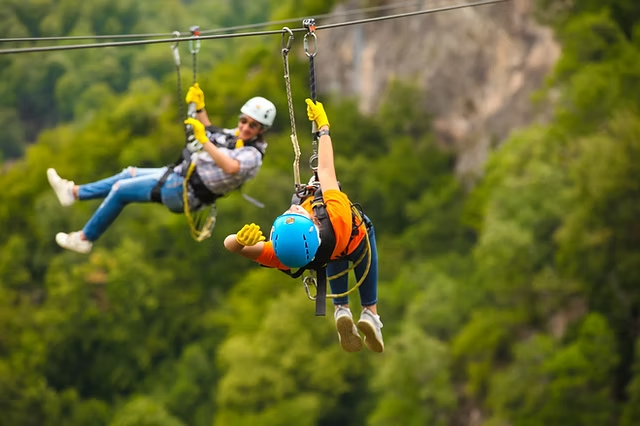
To visit "Yell" extreme Park
Yell Extreme Park is an extreme entertainment area in the Yenoqavan village of Tavush province. It is the first extreme themed entertainment park in Armenia. The park provides people with an opportunity to engage in extreme sports without professional preparation. Yenoqavan is 142 km away from Yerevan. The zipline was launched in the park from the very beginning, after which the park started to offer other types of extreme entertainment to people of different preferences.
Yell Extreme Park offers 5 different Zipline rope-ways, 135 to 750 m long.
Yell Extreme Park is an extreme entertainment area in the Yenoqavan village of Tavush province. It is the first extreme themed entertainment park in Armenia. The park provides people with an opportunity to engage in extreme sports without professional preparation. Yenoqavan is 142 km away from Yerevan. The zipline was launched in the park from the very beginning, after which the park started to offer other types of extreme entertainment to people of different preferences.
Yell Extreme Park offers 5 different Zipline rope-ways, 135 to 750 m long. The other services provided later are Horseback Riding, Paintball, Via Ferrata, Zorbing, Off-Road Tours, Rock Climbing and Rope Park. Yell extreme Park is not only a pleasant and unforgettable place to relax, but also a great way to get rid of old fears and overcome them.
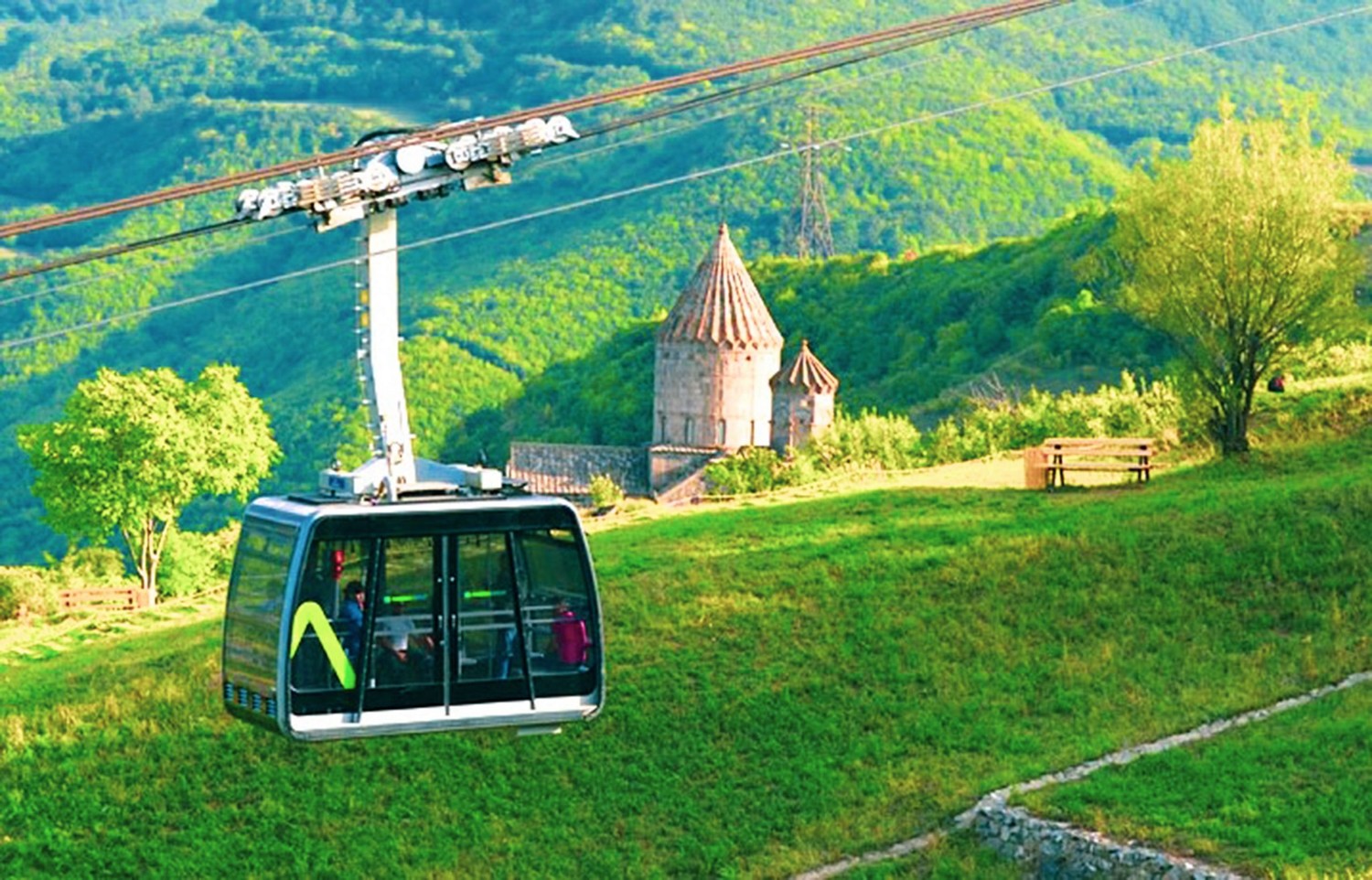
To fly by "Wings of Tatev"
The Tatev Monastery is located in the south of Tatev village, Syunik region, Republic of Armenia. In 1995 it was enlisted in the list of UNESCO historical and cultural heritage of Armenia.
One of the most interesting and attractive entertainment places for tourists - the "Tatever" or "Wings of Tatev" cable car, which stretches 5,7 km is located in Syunik region. The "Wings of Tatev" cable car was listed in the Guinness World Records as the longest non-stop reversible cable car in the world.
The Tatev Monastery is located in the south of Tatev village, Syunik region, Republic of Armenia. In 1995 it was enlisted in the list of UNESCO historical and cultural heritage of Armenia.
One of the most interesting and attractive entertainment places for tourists - the "Tatever" or "Wings of Tatev" cable car, which stretches 5,7 km is located in Syunik region. The "Wings of Tatev" cable car was listed in the Guinness World Records as the longest non-stop reversible cable car in the world. Each cabin accommodates 30 passengers and one attendant. The last section admires with a mindblowing view of Tatev Monastery. The cable car runs at a speed of 37 km per hour, it crosses the Vorotan River gorge, where the highest point is 320 m above the ground. The "Wings of Tatev" is a non-commercial project, the entire income is spent for the restoration of Tatev Monastery. The cable car flight leaves unforgettable impressions and an opportunity to admire the wonderful nature of Syunik.

To Taste Armenian brandy
Armenians have been engaged in winemaking and viticulture in the territory of modern Armenia since the 15th century BC. This is confirmed by ancient manuscripts and folk traditions. The works of Greek historians Herodotus, Xenophon, and Strabo mention that Armenian brandy was exported to neighboring countries for sale. The wine was of high quality, aged, and made from various grape varieties. Armenia is renowned for its ancient traditions of grape growing.
Brandy production in Armenia began in 1887.
Armenians have been engaged in winemaking and viticulture in the territory of modern Armenia since the 15th century BC. This is confirmed by ancient manuscripts and folk traditions. The works of Greek historians Herodotus, Xenophon, and Strabo mention that Armenian brandy was exported to neighboring countries for sale. The wine was of high quality, aged, and made from various grape varieties. Armenia is renowned for its ancient traditions of grape growing.
Brandy production in Armenia began in 1887. The first winery in Yerevan was founded by the merchant and philanthropist Nerses Tayryan. The process of making brandy followed the classical French technology. Over time, brandies with nearly 150 years of history gained a great reputation and popularity.
The Prime Minister of the United Kingdom, Winston Churchill, after tasting this drink, declared that from then on, he would not drink any other kind of brandy. Until his death (1965), Churchill regularly received 10 boxes (with 20 bottles in each) of Armenian brandy from the USSR, which he called the "Divine Drink."
Today, tasting tours are in high demand. During these tours, visitors are given a unique opportunity to learn about the technologies of brandy and wine production, developed and improved by Armenian winemakers over the centuries, visit the oldest and youngest brandy factories and wineries in Armenia, and see the storage of oak barrels. Many factories offer the chance to visit vineyards, learn about the aging technologies of brandy in barrels, and of course, enjoy their unique taste.
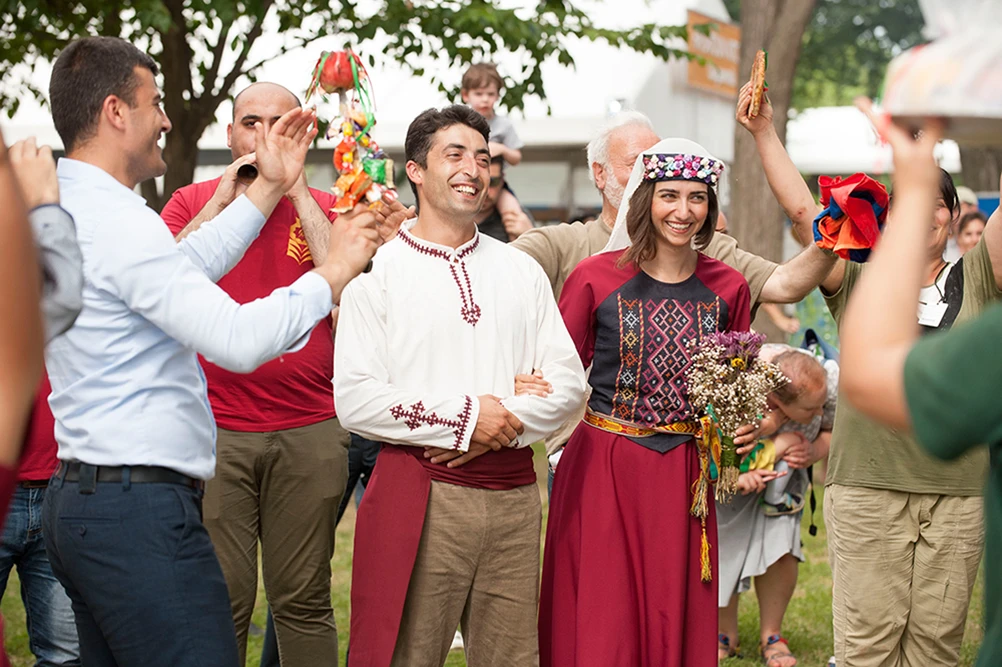
Visiting an Armenian Wedding
Building a family is one of the most important events in the lives of Armenians. Preparation for this event takes several months. Armenians invite a large number of guests, great them with songs and dances, keep beautiful traditions and exchange gifts. Armenians spare no effort or expenses in organizing the wedding ceremony and the bride and the groom become true king and queen of this day. Each ethnographic region of Armenia historically had its own wedding traditions, although many of them were common to almost all regions.
Building a family is one of the most important events in the lives of Armenians. Preparation for this event takes several months. Armenians invite a large number of guests, great them with songs and dances, keep beautiful traditions and exchange gifts. Armenians spare no effort or expenses in organizing the wedding ceremony and the bride and the groom become true king and queen of this day. Each ethnographic region of Armenia historically had its own wedding traditions, although many of them were common to almost all regions. The celebration would begin the day before the wedding. In the past, the entire village, relatives and close friends would gather at the bride’s house to bake festive bread, lavash and gata. Armenians have always highly valued the marriage ceremony in the church, so they rarely miss this ritual. After receiving the blessing in the church, exchanging rings and making vows of loyalty and devotion, the wedding procession would head to the groom’s house. When the wedding ceremony moves to the restaurant, the role of the host or tamada begins. He must know the proper order of toasts according to family priorities. At some point during the party, the couple invites all the unmarried young ladies and gentlemen to the center of the hall and gives them tarosiks (small souvenirs), which is a symbol of the wedding and a wish for the young people to soon start their own families. Modern Armenian weddings feature fireworks, performances of popular singers, entertainment games, folk and modern dances. A wedding is one of the most loved and anticipated events for Armenians.
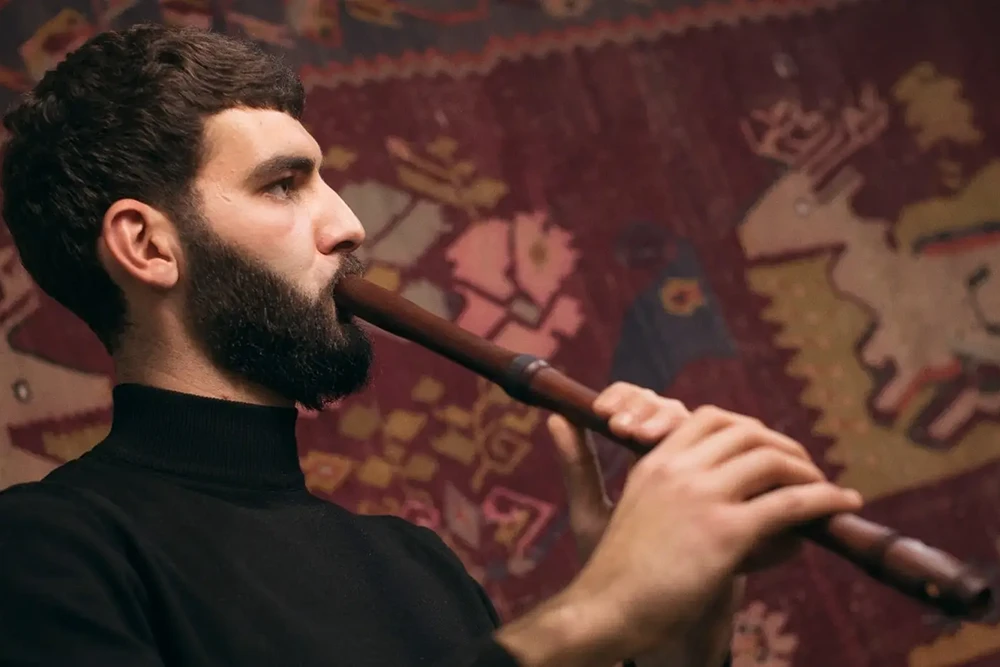
Listening to Duduk and Jazz
The duduk is an Armenian traditional wind instrument. The duduk is one of the characteristic symbols of Armenian folk musical culture. This instrument, made from apricot wood, is very popular not only among professional musicians but also among amateur musicians. The world-renowned composer Aram Khachaturian wrote: "The duduk is the only instrument the sound of which makes me cry." Researchers claim that the history of the duduk spans 1,500 years.
The duduk is an Armenian traditional wind instrument. The duduk is one of the characteristic symbols of Armenian folk musical culture. This instrument, made from apricot wood, is very popular not only among professional musicians but also among amateur musicians. The world-renowned composer Aram Khachaturian wrote: "The duduk is the only instrument the sound of which makes me cry." Researchers claim that the history of the duduk spans 1,500 years. The history of the Armenian duduk dates back to the time of King Tigran the Great, who reigned from 95 to 55 BC. According to ethnomusicologist Jonathan McCollum, "This [duduk] is the only Armenian musical instrument that has survived to this day and is a symbol of Armenian identity. The main feature of the duduk is its ability to convey the nuances of the Armenian language to the listener." In 2005, UNESCO declared the Armenian musical instrument duduk one of the masterpieces of the oral and intangible cultural heritage of humanity. In 2008, UNESCO included the element of Armenian intangible cultural heritage called "Duduk and its music" in the list of intangible cultural heritage of humanity.
In Yerevan, jazz is invariably associated with Levon Malkhasyan. The famous composer and performer once said in an interview: "As far as I remember, jazz has always been popular and in demand in Yerevan. In general, Armenia is a country of continuous jazz boom." In 1968, Malkhasyan organized the Republican Jazz Festival for the first time. Yerevan breathes jazz all year round. There are many clubs where jazz enthusiasts can enjoy music in the evening.
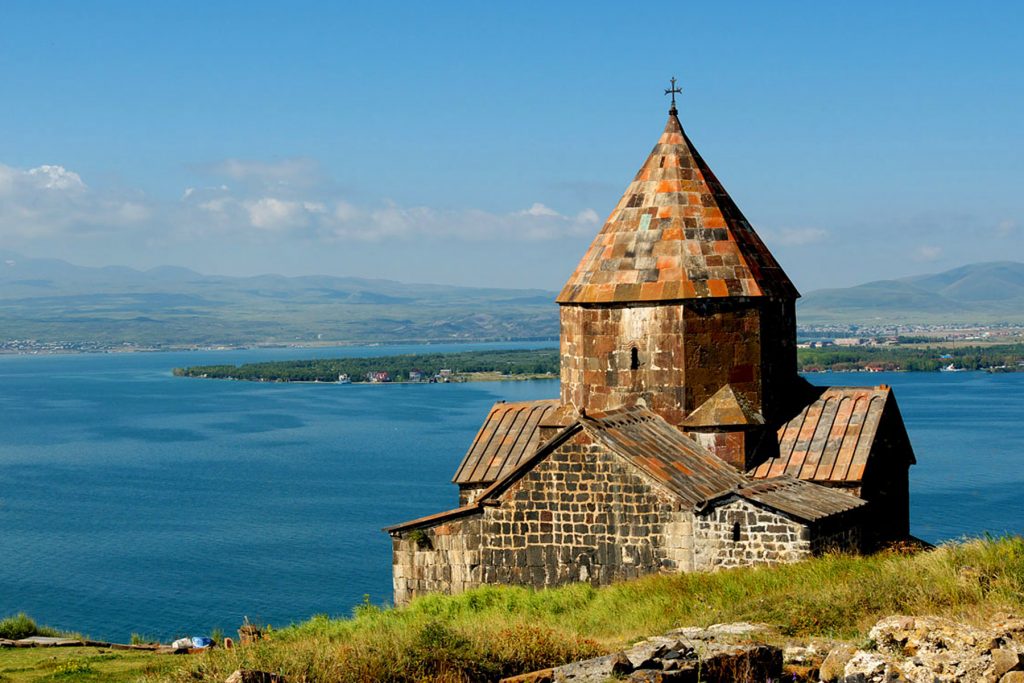
A visit to Lake Sevan
Lake Sevan is the freshwater gem of Armenia, the largest mountain reservoir, which is not only a beautiful place for relaxation but also a unique opportunity for people who are interested in sailing, fishing, speed motorboats, diving, and underwater swimming. Lake Sevan is located at an altitude of 1900 meters above sea level. The lake's length is 70 km, and its maximum width is 55 km. The surface area of the lake is 1260 km², making it the largest lake in the South Caucasus. The highest water temperature in the summer can reach 24-25°C.
Lake Sevan is the freshwater gem of Armenia, the largest mountain reservoir, which is not only a beautiful place for relaxation but also a unique opportunity for people who are interested in sailing, fishing, speed motorboats, diving, and underwater swimming. Lake Sevan is located at an altitude of 1900 meters above sea level. The lake's length is 70 km, and its maximum width is 55 km. The surface area of the lake is 1260 km², making it the largest lake in the South Caucasus. The highest water temperature in the summer can reach 24-25°C. There are many resort areas, hotels and cottages here on the shores that can be rented. There are equipped municipal and private beaches, which may be free or with fee. The cultural and religious center of Sevan is the Sevan Peninsula, with the Sevanavank monastery, founded in the 4th century and the Churches of the Holy Apostles and Saint John the Baptist, built in the 9th century. This is a place of pilgrimage where people come to baptize children, get married or participate in a liturgy. The monastery is located quite high above the lake, offering an unforgettable and beautiful view of the Sevan shoreline. The constant inhabitants of the lake, seagulls, always soar flying above it, completing the stunning panorama of the lake.

To play Chess and Backgammon
Backgammon is a board game played by two players. It is one of the oldest known board games in human history. In Armenia, backgammon is not just a game, but a way of life—it's the most beloved pastime of adults and one of the most popular forms of entertainment among Armenians. Armenians play backgammon everywhere: at home, visiting friends and even take it on picnics. Backgammon can also be a great gift for those who love the game.
Backgammon is a board game played by two players. It is one of the oldest known board games in human history. In Armenia, backgammon is not just a game, but a way of life—it's the most beloved pastime of adults and one of the most popular forms of entertainment among Armenians. Armenians play backgammon everywhere: at home, visiting friends and even take it on picnics. Backgammon can also be a great gift for those who love the game. At Vernissage in the center of Yerevan, one may find pavilions offering a wide range of handmade wooden backgammon sets. For elderly Armenians, backgammon is also the main courtyard entertainment.
Chess is considered the king of sports in Armenia. Although Armenia is a small country geographically, it is a superpower in the world of chess. It frequently celebrates victories in international tournaments. Chess has been known in Armenia since the early Middle Ages, but it became especially popular during the Soviet era. It is one of the most popular games in the country. Children, teenagers and adults all play chess. Chess became particularly popular in Armenia in the 1960s after Tigran Petrosian's victory in the World Chess Championship.
In terms of the number of grandmasters per capita, Armenia is one of the top countries. Chess is so popular among Armenians that in the 2011-2012 school year, it became a mandatory subject in Armenian public schools.
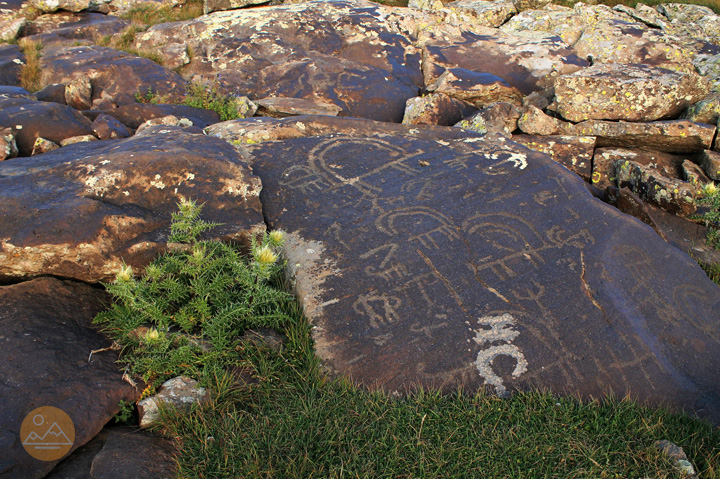
Explore Armenian Petroglyphs
Rock art or petroglyphs are ancient images and scenes on the walls of caves, ceilings and rock and stone surfaces. The ancient layers of Armenian pictorial culture, the petroglyphs, are "paintings" on stone that artistically reflect the realities of the past. The first petroglyphs were discovered in Armenia between 1902 and 1910, and already in 1913, Grigor Gapantsyan wrote an extensive article in No. 1 of the "Ararat" magazine about the discovered rock paintings. Armenia has several regions where many petroglyphs have been found.
Rock art or petroglyphs are ancient images and scenes on the walls of caves, ceilings and rock and stone surfaces. The ancient layers of Armenian pictorial culture, the petroglyphs, are "paintings" on stone that artistically reflect the realities of the past. The first petroglyphs were discovered in Armenia between 1902 and 1910, and already in 1913, Grigor Gapantsyan wrote an extensive article in No. 1 of the "Ararat" magazine about the discovered rock paintings. Armenia has several regions where many petroglyphs have been found. Among them are Aragats, the Geghama Mountains, Syunik and the slopes of Ukhtasar. In these regions, a total of 20,000 petroglyphs have been discovered, with more than 6,000 found in the Ukhtasar region of Syunik. The petroglyphs date back to 7000 BC and even earlier. In early 1966, around 30,000 petroglyphs were found on the Geghama Plateau, followed by discoveries in the Vardenis mountain range and on the slopes of Mount Aragats. In 1967, three ancient objects were found in the Vardenis mountains, which, according to researchers, particularly Dr. Benik Tumanyan, are considered to be: "Stone evidence of the astronomical thinking of our distant ancestors."

